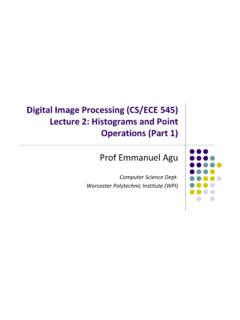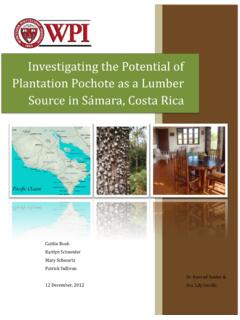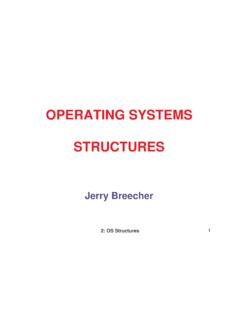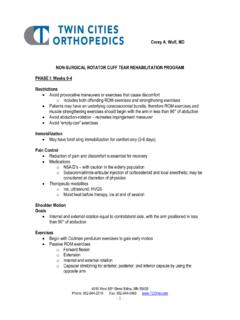Transcription of OPERATING SYSTEMS OVERVIEW - WPI
1 1: OPERATING SYSTEMS Overview1 Jerry BreecherOPERATING SYSTEMS OVERVIEW1: OPERATING SYSTEMS Overview2 WHAT IS AN OPERATING system ? An interface between users and hardware - an environment "architecture Allows convenient usage; hides the tedious stuff Allows efficient usage; parallel activity, avoids wasted cycles Provides information protection Gives each user a slice of the resources Acts as a control system OVERVIEW1: OPERATING SYSTEMS Overview3 OPERATING system OVERVIEWThe Layers Of A SystemProgram InterfaceHumansUser Interface/ Privileged InstructionsDisk/Tape/Memory1: OPERATING SYSTEMS Overview4A mechanism for scheduling jobs or processes. Scheduling can be as simple as running the next process, or it can use relatively complex rules to pick a running method for simultaneous CPU execution and IO handling.
2 Processing is going on even as IO is occurring in preparation for future CPU Line Processing; not only are IO and CPU happening concurrently, but some off-board processing is occurring with the system OVERVIEWC omponents1: OPERATING SYSTEMS Overview5 The CPU is wasted if a job waits for I/O. This leads to: Multiprogramming ( dynamic switching ). While one job waits for a resource, the CPU can find another job to run. It means that several jobs are ready to run and only need the CPU in order to scheduling is the subject of Chapter of this leads to: memory management resource scheduling deadlock protectionwhich are the subject of the rest of this system OVERVIEWC omponents1: OPERATING SYSTEMS Overview6 Other Characteristics include: Time Sharing- multiprogramming environment that's also interactive.
3 Multiprocessing - Tightly coupled SYSTEMS that communicate via shared memory. Used for scientific applications. Used for speed improvement by putting together a number of off-the-shelf processors. Distributed SYSTEMS - Loosely coupled SYSTEMS that communicate via message passing. Advantages include resource sharing, speed up, reliability, communication. Real Time SYSTEMS - Rapid response time is main characteristic. Used in control ofapplications where rapid response to a stimulus is system OVERVIEWC haracteristics1: OPERATING SYSTEMS Overview7 OPERATING system OVERVIEWC haracteristicsInterrupts: Interrupt transfers control to the interrupt service routine generally, through the interrupt vector, which contains the addresses of all the service routines. Interrupt architecture must save the address of the interrupted instruction.
4 Incoming interrupts are disabledwhile another interrupt is being processed to prevent a lost interrupt. A trapis a software-generated interrupt caused either by an error or a user request. An OPERATING system is : OPERATING SYSTEMS Overview8 OPERATING system OVERVIEWH ardwareSupportThese are the devices that make up a typical of these devices can cause an electrical interrupt that grabs the attention of the : OPERATING SYSTEMS Overview9 OPERATING system OVERVIEWH ardwareSupportSequence of events for processing an IO Synchronous and Asynchronous IO Operations1: OPERATING SYSTEMS Overview10 OPERATING system OVERVIEWH ardwareSupportThis is Bookkeeping. These structures are necessary to keep track of IO in : OPERATING SYSTEMS Overview11 Very fast storage is very expensive. So the OPERATING system manages a hierarchy of storage devices in order to make the best use of resources.
5 In fact, considerableeffort goes into this system OVERVIEWS torageHierarchyFast and ExpensiveSlow an Cheap1: OPERATING SYSTEMS Overview12 Performance: OPERATING system OVERVIEWS torageHierarchy1: OPERATING SYSTEMS Overview13 Caching: Important principle, performed at many levels in a computer (in hardware, OPERATING system , software) Information in use copied from slower to faster storage temporarily Faster storage (cache) checked first to determine if information is there If it is, information used directly from the cache (fast) If not, data copied to cache and used there Cache smaller than storage being cached Cache management important design problem Cache size and replacement policyOPERATING system OVERVIEWS torageHierarchy1: OPERATING SYSTEMS Overview14 The goal is protecting the OPERATING system and others from malicious or ignorant User/Supervisor Modeand threads might interfere with others.
6 This leads to protection of resources by user/supervisor mode. These resources include:I/ODefine I/O instructions as privileged; they can be executed only in Supervisor mode. system calls get us from user to supervisor mode. OPERATING system OVERVIEWP rotection1: OPERATING SYSTEMS Overview15 Memory A user program can only access its own logical memory. For instance, it can't modify supervisor code. Depends on an address translation scheme such as that shown here. OPERATING system OVERVIEWP rotection1: OPERATING SYSTEMS Overview16 CPUA clock prevents programs from using all the CPU time. This clock causes an interrupt that causes the OPERATING system to gain control from a user system OVERVIEWP rotectionFor machines connected together, this protection must extend across:Shared resources, Multiprocessor Architectures, Clustered SystemsThe practice of this is called distributed OPERATING SYSTEMS .
7 1: OPERATING SYSTEMS Overview17 WRAPUPWe ve completed our first OVERVIEW of an OPERATING system this was the equivalent of a Satellite next view will be at the level of a high flying that, we ll be at ground level, looking at pieces in system OVERVIEW











